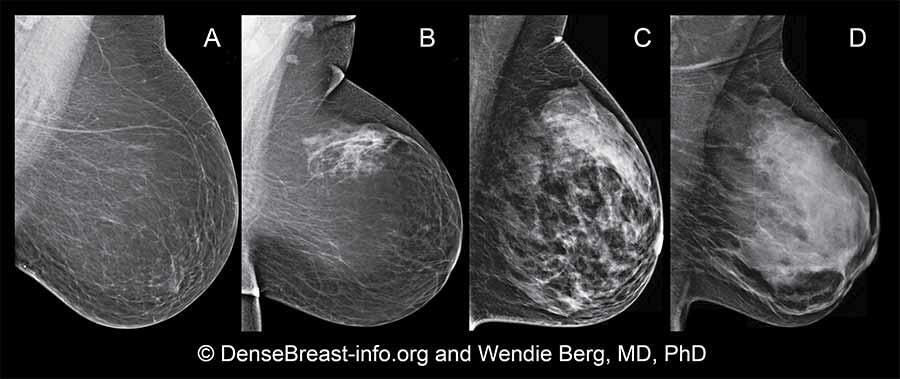What is breast density?
The concept of breast density is a relatively new understanding that individuals might come into contact with for the first time when receiving a mammography examination. Breast density cannot be determined by size, feel, or touch, therefore it is understandable that many are not familiar with this underlying risk. The breast is made up of milk glands, milk ducts and connective tissue (dense breast tissue), and fatty tissue (non-dense tissue). When a larger proportion of the breast is composed of connective and breast tissue rather than fatty tissue, the woman is said to have dense breasts.
Breast density can be divided into two categories of low and high density, which can be distinguished by a radiologist after examining an x-ray image from mammography. High breast density is not uncommon and indeed is found in around 50-60% of women aged 40-49 years(1). Breast density tends to undergo the most amount of changes around the menopausal period, simultaneously influenced by fluctuations in hormones, body mass index (BMI), and lifestyle behaviours. Current scientific research into breast density remains largely limited to the middle and older age women, who are the target group to receive mammograms. There are two significant correlations related to breast density that need to be considered:
- Breast density is one of breast cancer’s strongest risk factors.
- Increased breast density reduces the sensitivity of mammography, making the detection of tumours and other physiological changes in the breast much more challenging.
The majority of women remain largely unaware of their breast density and therefore do not recognize the increased risk of breast cancer associated with it. The results of a recent study demonstrated that only 36% of women were informed about their breast density, and significantly less were aware of the meaning behind this adverse risk factor (3). While research on the cause behind the correlation is ongoing, current data shows that women with 75% or greater percent breast density are 4-6 times more likely to get breast cancer than women with low density (2). For women with a family history of dense breasts, the breast cancer risk is even higher. While there is no optimal age to find out your breast density, knowing your risk category and tracking changes in your breast density will only benefit your health in the long term.
Dense breast tissue can look light grey or white on a mammogram. In the x-ray image below a range of breast density is visible, where (A) is an entirely fatty breast and (D) is extremely dense.

Having dense breasts can make it hard to see abnormal findings on a mammogram. This is relevant to consider at any age but can become even more acute for older women who are at a greater risk of developing breast cancer. As part of the National Health Service programme, women are recommended to receive their first mammography at age 40 and follow a regular screening procedure every 2 years starting from age 50. Breast density is a physical trait that fluctuates throughout the lifetime, therefore understanding breast density at every stage by following routine examinations is important.
Breast density varies greatly by age and weight. Another particular population group that tends to have a higher likelihood of having dense breasts are thin and young women. Although young women are not the target group to receive regular mammography screenings, in cases where a more in-depth examination is necessary other alternatives, such as ultrasonography or MRI might be necessary to accommodate. If you fall into this category and are interested in finding out personalized screening recommendations, talk to your gynaecologist or family physicians about the breast examination method that best fits you.
With the knowledge of finding out you have above average or high breast density comes the need to dedicate closer attention to mitigating and controlling the risk of developing breast cancer. This not only includes general recommendations of maintaining healthy lifestyle habits of regular physical exercise and nutritious diet but also the inclusion of regular screening procedures. After finding out you have dense breast tissue, starting a conversation with your physician might be the first and best step to take. To learn more about topics associated with available screening methods as well as the breakdown of the effects of family history and genetic testing read here.
- Ahern, Thomas P, et al., 2017. Family history of breast cancer, breast density, and breast cancer risk in a U.S. breast cancer screening population. Cancer epidemiology, biomarkers & prevention, 26(6), pp.938–944.
- Anon, 2020. What do women know about breast density? A public screening program perspective (Published April 3, 2020). Obesity, fitness, & wellness week, p.798.
- Yaghjyan, Lusine, et al., 2015. Mammographic breast density and breast cancer risk: interactions of percent density, absolute dense, and non-dense areas with breast cancer risk factors. Breast cancer research and treatment, 150(1), pp.181–189.
- Centers for Disease Control and Prevention. 2021. What Does It Mean To Have Dense Breasts?. [online]
Image reference:
https://www.cancer.gov/types/breast/breast-changes/dense-breasts
